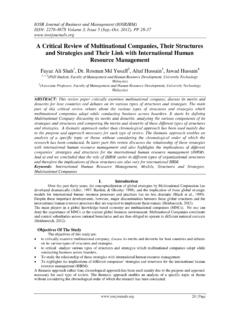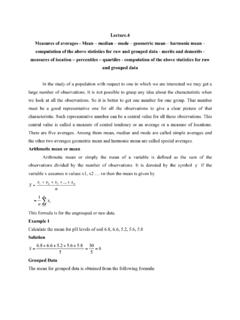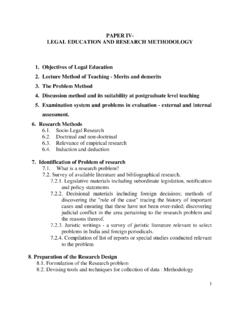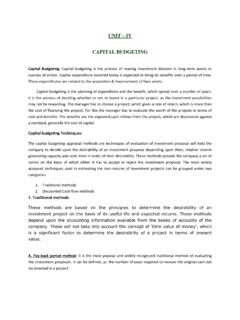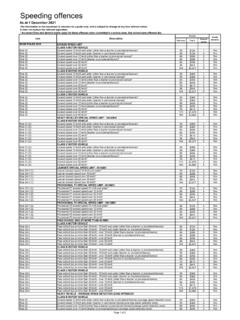Transcription of B.Sc ( HORTICULTURE ) SEMESTER – I PAPER – I: Fundamentals ...
1 1 ( HORTICULTURE ) SEMESTER I PAPER I: Fundamentals of HORTICULTURE Theory Introduction and Principles of HORTICULTURE : Unit - I Definition of HORTICULTURE . Importance of HORTICULTURE in terms of economy, production, employment. generation, environmental protection and human resource development . Scope for HORTICULTURE in India. Nutritive value of horticultural crops . Divisions of HORTICULTURE with suitable examples and their importance. Classification of HORTICULTURE crops based on soil and climatic requirements. Fruit and Vegetable zones of India and Andhra Pradesh. Unit II Definition of a nursery. Different types of nursery beds flat beds, raised beds and sunken beds, their merits and demerits . Different nursery techniques and their management. Vegetable gardens, nutrition and kitchen garden, truck garden, Vegetable forcing, market gardens and roof gardens.
2 Different steps in planning and layout establishment and management of orchards. Different s systems of planting orchards - square, rectangle, quincunx, hexagonal and contour systems of planting their merits and demerits . Calculation of planting densities in different systems of planting. Unit III Pruning: Definition, objectives. Principles and methods of pruning of fruit crops. Training: Definition, objectives. Principles and methods of training of fruit crops: Open centre, Closed centre and Modified leader systems, their merits and demerits . Bearing habits in horticultural crops. Irrigation: definition, different methods of irrigation followed in horticultural crops, their merits and demerits . Manures and fertilizers: Definition, different methods of application of manures and fertilizers to horticultural crops.
3 2 Preharvesting and Propagation of Horticultural Plants: Unit IV Cropping systems: Inter cropping and multi tier cropping, their merits and demerits with suitable examples. Practical uses of growth regulators in HORTICULTURE . Fruitfulness and unfruitfulness: Definitions, Factors influencing the fruitfulness and unfruitfulness with suitable examples. Rejuvenation of old orchards, Importance of rejuvenation: Top working and Frame working. Maturity: Definition, Different methods to judge maturity in horticultural crops. Unit- V Propagation: Definition, Methods, Sexual and asexual, advantages and disadvantages of each method, Asexual method of propagation, propagation by division and separation. Propagation by cuttings: Definition of cutting, Different methods of cuttings, semi hard wood, soft wood and herbaceous stem cuttings, examples for each type; Leaf cuttings.
4 Plant propagation by layering: Definition of layering and layer; Types of layering : Ground layering Tip layering, Simple layering, Trench layering, Mound or Stool layering and Compound or Serpentine layering, examples for each type; Air layering examples. Plant propagation by grafting: Definition; methods of grafting: Attached scion methods of grafting, Simple inarching or approach grafting; Detached scion methods of grafting: Pre-curing of scion, Side grafting methods:Veneer grafting, Apical grafting methods, Epicotyle grafting, Soft wood grafting, Double working, Top working. Plant propagation by budding: Definition of budding; Methods of budding: T- budding and Inverted T- budding, patch budding and ring budding. Practicals 1. Study of tools and implements in HORTICULTURE . 2. Layout of different planting systems. 3. Layout of nutrition garden.
5 4. Preparation of nursery beds for sowing of vegetable seeds. 3 5. Digging of pits for fruit plants. 6. Preparation of fertilizer mixtures and field application. 7. Identification and management of nutritional disorders in vegetables. 8. Study and practicing of different propagation methods by cutting, layering, division. 9. Study and practicing of different propagation methods by grafting and budding. Reference Books: 1 Fundamentals of HORTICULTURE , Edmond, , Sen., , Andrews, and Halfacre , 1963. Tata McGraw Hill Publishing Co., New Delhi. 2 Introduction to HORTICULTURE , Kumar, N. 1990. Rajyalakshmi Publications, Nagarcoil, Tamilnadu. 3 Basic HORTICULTURE , Jitendra Sing, 2002. Kalyani Publishers, Hyderabad. 4 Fundamentals of Fruit Production, Garner V R, Bradford F C and Hooker Jr. H D, 1957. McGraw Hill Book Co.
6 , New York. 5 Plant Propagation. Principles and Practices, Hartman, HT and Kester, , Prentice Hall of India Pvt. Ltd. Bombay. 6 Plant Propagation. Sadhu, 1996. New Age International Publishers, New Delhi. 7 Propagation of Fruit Crops, Mukherjee, and Majumdar, ICAR, New Delhi. 8 Propagation of Tropical Fruit Trees, Ganner, and Choudari, 1972. Oxford & IBH Publishing Co., New Delhi. 9 Propagation of Horticultural Crops: Principles and Practices, Sarma, 2002. Kalyani Publishers, New Delhi. ACHARYA NAGARJUNA UNIVERSITY ( HORTICULTURE ) , SEMESTER II Sno Course Total Marks Mid Sem Exam Sem End Exam Teaching Hours Credits 1 First Language English 100 25 75 4 3 2 Second Language (Tel/Hin/ ) 100 25 75 4 3 3 Foundation course - 3 Environmental Sci 50 0 50 2 2 4 4 Foundation course 4A ICT 1 (Information & Communication Technol) 50 0 50 2 2 5 DSC* 1 B (Group Sub- 1) 100 25 75 4 3 6 DSC 1 B Lab Practical 50 0 50 2 2 7 DSC 2 B (Group Sub- 2) 100 25 75 4 3 8 DSC 2 B Lab Practical 50 0 50 2 2 9 DSC 3 B (Group Sub- 3) 100 25 75 4 3 10 DSC 3 B Lab Practical 50 0 50 2 2 Total 750 - - 30 25 ACHARYA NAGARJUNA UNIVERSITY ( HORTICULTURE ) ( HORTICULTURE ) SEMESTER II PAPER II: Postharvest Technology Of Horticultural Crops Theory Unit I Importance of Postharvest handling.
7 Maturity and maturity indices of Horticultural crops. Harvesting methods of Horticultural crops. Factors responsible for maturity, ripening and deterioration of Horticultural crops. Preharvest factors: Selection of varieties, Cultural operations, Preharvest treatment Maturity and Harvesting. Unit II Postharvest factors: Curing, degreening, precooling, washing and drying, storing and grading, disinfestations, Postharvest treatments and Waxing. Physiological and Biochemical changes during ripening. Harvesting of horticultural crops: Manual and Mechanical methods of harvesting. Methods used for hastening and delaying ripening: Chemicals that hasten ripening and chemicals that delay ripening. Ethylene in Postharvest technology. Unit III Respiration and transpiration in relation to harvesting, packing, transportation and storage. Nature and causes of deterioration: a) Primary causes of losses i) Mechanical losses, ii)Physio-biochemical losses, iii)Microbial losses, iv)Physical losses.
8 5 Secondary causes of losses. Impact of postharvest losses. Technologies for minimizing losses . Methods of precooling, grading, packaging, storage and transport of horticultural crops. Unit IV Principles and method of preservation: Preservation by asepsis, high temperature, low temperature, chemicals, drying, filtration, carbonation, sugar, salt, fermentation, acids, oil and spices, antibiotics, irradiation. Canning and bottling of fruits and vegetables. Causes for spoilage of canned foods. Unfermented fruit beverages: Preparation and preservation of unfermented fruit beverages Juices, RTS, Nectar, Cordial, Squash, Syrup, Fruit juice concentrate, Crush. Unit V Fermented fruit beverage: Different types of wine preparation. Jams, jellies and Marmalades Procedure for preparation. Preservation by sugar: Candies, Crystallized fruits, Preservation, procedure for preparation.
9 Preservation by salt: Pickles. Food laws. Practicals 1 Visit to a commercial nurseries in the locality and adjoining areas. 2 Microscopic studies on foliar diseases of horticultural crops. 3 Practice in judging the maturity indices of fruits and vegetables. 4 Preparation of juices and squashes. 5 Preparation of jam and jelly. 6 Preparation of ketchup and sauce. 7 Preparation of pickles. Reference Books: 1 Postharvest Technology of Fruits and Vegetables, Thompson, Blackwell science, London. 2 Principles and Practice of Postharvest Technology, Pandey, 1998. Kalyani Publisher, Ludhiana. 3 Postharvest Technology of Horticultural Crops, Sudheer, 2007. New India Publishing Agency, New Delhi. 4 Fruit and Vegetable Preservation Principles Practice, Srivastava, and Sanjeev Kumar 1998. International Book Distribution Co., Lucknow.
10 5 Preservation of Fruits and Vegetables. Girdharilal, G. S., Siddappa and Tandon, 1998. ICAR, New Delhi. 6 6 A Handbook on Postharvest Management of Fruits & Vegetables, John 2008. Baya publishing House, Delhi. 7 Postharvest An Introduction to the Physiology & Handling of Fruits & Vegetables, Wills, Glassan, D. Graham, Lee & Hall. CBS Publishers & Distributors, New Delhi . 8 Small scale Postharvest Technology, Kitinoja, L& Kader, 2002. Research and Information Center, University of California , Davis. ACHARYA NAGARJUNA UNIVERSITY ( HORTICULTURE ) , SEMESTER III SEMESTER III Sno Course Total Marks Mid Sem Exam Sem End Exam Teaching Hours Credits 1 First Language English 100 25 75 4 3 2 Second Language (Tel/Hin/ ) 100 25 75 4 3 3 Foundation Course - 5 Entrepreneurship 50 0 50 2 2 4 Foundation course -2B Communication & Soft Skills -2 50 0 50 2 2 5 DSC 1 C (Group Sub- 1) 100 25 75 4 3 6 DSC 1 C Practical 50 0 50 2 2 7 DSC 2 C (Group Sub- 2) 100 25 75 4 3 8 DSC 2 C Practical 50 0 50 2 2 9 DSC 3 C (Group Sub- 3) 100 25 75 4 3 10 DSC 3 C Practical 50 0 50 2 2 Total 750 - - 30 25 7 ACHARYA NAGARJUNA UNIVERSITY ( HORTICULTURE ) ( HORTICULTURE ) SEMESTER III PAPER III PRODUCTION TECHNOLOGY OF FRUIT CROPS Theory syllabus Unit I: Introduction to Fruit Crops Importance of fruit growing in India and Andhra Pradesh.


